
Syllabus for Introduction to Cultural Anthropology at Queens College
- Subject:
- Anthropology
- Social Science
- Material Type:
- Syllabus
- Provider:
- CUNY Academic Works
- Provider Set:
- Queens College
- Author:
- Emoto, Tomomi
- Date Added:
- 01/01/2021

Syllabus for Introduction to Cultural Anthropology at Queens College

This course introduces the methods that archaeologists utilize to reconstruct cultural developments of the past and traces the origins of complex social organization in various locations throughout the world. Beginning with the earliest evidence of stone tool production (ca. 2 million years ago), we will examine the interrelationship of complex social organization, population growth, the development of agriculture, writing, social inequality, and cities.
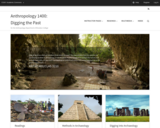
How do we know what we believe to know about the past? This class will dive into this question by introducing students to archaeology, a sub-discipline of anthropology that explores the human past through materiality. An overview of archaeological method and theory and current approaches to the practice. Topics will include history of the discipline, how societies were organized, subsistence patterns, technology and trade, and analytical approaches. In addition, the course will explore some of the present issues within the field of archaeology. Class will use lectures, class discussions, reading materials, visual media, and guest lectures to explore the topics discussed above.

Syllabus for Anthropology of East Asia at Queens College
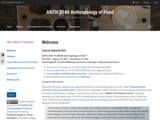
“Eating and food provide some of the most basic ways in which humans define themselves. A cross-cultural consideration of nutrition, food production and food as social practice will help to define the place of food and eating in basic human practice.” (Brooklyn College Course Catalog, 2022)
Food is an essential component for the survival of any living organism. Such as the case with humans, that in order to live, they need to eat. Food gives us an opportunity to see the similarities and differences among cultural groups, one group’s delicacies are another’s taboos. Why is food inherently part of culture? This is one of the main questions we will attempt to respond to in this course. Food is part of an economic system, but also part of a political and symbolic imaginary. In this course, we will cover an array of topics that include: food production, exchange, and consumption; power, politics, migration, labor, race, gender, space, language, nutrition, and eating. This experience will give us an opportunity to see how intrinsic food and eating are, not only for the survival of our species, but as part of culture and society.

As organisms, humans need to eat to live. As cultural beings, eating and food provide some of the most basic ways in which humans define themselves. One group’s delicacies are another’s taboos, and what defines comfort foods and favorite dishes shifts drastically across cultures and individuals. Eating and food are simultaneously profoundly personal, deeply cultural, inherently economic, and increasingly political. This course is organized around the production, circulation, and consumption of food, and the political and economic effects of those processes. Students will learn to use food as an analytical entry point for thinking about relationships among humans and with non-human beings.

This course engages students in the diversity of American urban life and introduces various modes of analyzing socio-cultural scenes, communities, and urban institutions. In the first part of the course, we will lay the foundations for understanding urban processes and communities. We will examine the racial and ethnic diversity in cities and the ways people understand and cope with being in an environment filled with "strangers". We will develop an understanding of urban political economy and the effects of inequality and economic strain on urban life. In the second part of the course, we will focus on the effects of globalization, post-industrial decline, and post-modernism on cities. In this section, we will focus on the production and consumption of urban spaces. We will look at the ways American cities have developed and changed as well as the competing views and political contestations behind these transformations.
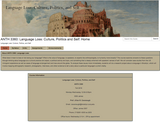
Libguide OER for Prof. Jill Cavanaugh's course: ANTH 3360: Language Loss: Culture, Politics and Self. What does it mean to lose or risk losing your language? What is the value of language, to speakers, to experts like anthropologists, to humanity more broadly? This course explores answers to these questions through thinking about language as a cultural practice and object, a political activity and topic, and something that is deeply entwined with speakers’ senses of self. We will consider case studies from the US immigrant experience as well as cases of language endangerment and loss around the globe. To analyze these issues more immediately, students will do a research project about a language in Brooklyn, which will involve mapping ethnographic research, photographic, interviews, and other evidence to tell a story about a particular language’s current vitality

About Urban Archaeology
Archaeology is undoubtedly most famous for its exploration and discovery of “wonderful things” from the deep past in “exotic” places: Tutankhamun’s tomb! Lost Maya cities! Archaeologists are also keen sift through and ask questions of ancient garbage: What do these tools at Stonehenge suggest about Neolithic and Bronze Age social networks? These discoveries and questions are important for understanding where we came from. However, more and more archaeologists are turning their attention, their theory, and their methods to the recent past and contemporary worlds. This course explores a body of work that advances these efforts in American urban places and considers debates that make the more recent American urban world its object. The course then asks students to assess and evaluate various aspects of American urban life through exposure to a broad range of archaeological case studies.
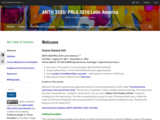
In this course, we will focus on a survey of topics that will help us hone the discussion on cultural production, manifestations, and contestations. The course will provide an interdisciplinary perspective grounded in Anthropology, but also including materials from other fields in the social sciences, such as History, and Cultural Studies. The course will also introduce students to the four-field approach in Anthropology (Cultural Anthropology, Biological Anthropology, Archaeology, and Linguistics). The geographical region that will be covered in this class will be South America. This will provide students with a context to discuss topics that include culture, race, and ethnicity, connecting it to the main arguments around cultural difference, identity, political economy, political economy, health, food, environment, language, politics, gender, sports, and religion.

This seminar is titled “Brazil: Race, Class, and Gender,” and while the objective of the course is to attend to and explore each of these facets of Brazilian life, the structure of the course in fact reveals the difficulty and indeed impracticality of isolating for study any of the above components – race, class, or gender. Although drawing primarily on the work of anthropologists, we will also read from an interdisciplinary sampling of sociology, social history, literature, and poetry produced by both Brazilian and foreign authors.
The course begins with a brief, historical overview of contemporary Brazil, starting with the region’s indigenous populations, European contact, colonization, and early nation building. We will examine the significance of slavery in Brazil, explore the multiple meanings of “racial democracy” as the term relates to notions of Brazilian national identity, and unpack shifting racial ideologies of the 20th Century. The course will be similarly concerned with shifting notions of masculinity and femininity, sexuality, and of course what all of this might mean in a country that is understood by much of the “outside world” as an epicenter of sensuality. Finally, this course looks to the history of social thought concerning race, class, and gender in Brazil to make sense of current social and political unrest.

A study of the principles of art applied to visual forms, with emphasis on modern art of the nineteenth and twentieth centuries in Europe and the United States.
The full course site is available at https://arh141.commons.gc.cuny.edu/.
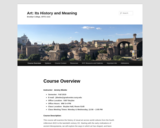
Examine the history of visual art across world cultures from the fourth millennium BCE to the twentieth century CE. Starting with the early civilizations of ancient Mesopotamia, we will explore the ways in which art has shaped, and been shaped by,the development of empires, cities, religions, politics, and social life through history. Our focus will be on major monuments and artworks that are exemplary of their time and place, but we will also look at lesser known objects to nuance and deepen our historical understanding. Classes will be primarily lecture-based, with time for discussion and questions as we explore the issues raised by both the artworks and the required readings.

An introduction to the history of art, emphasizing visual literacy in an historical context. Major works of art and architecture, drawn from a wide range of world cultures and periods from ancient times to the present, will be explored.
Students will learn to analyze works of art critically from both an historical and an interpretative point of view; in addition, they will gain an understanding of the importance of cultural diversity through exposure to the arts of many different times and places.
Students will have extensive practice in articulating aesthetic judgments effectively in spoken and written form.
Students will learn how to draw upon the cultural riches of New York City to enhance their learning within and outside the classroom.
Identify unique characteristics of several artistic traditions, and recognize and analyze the differences among the major periods, artists, genres, and theories of art.
Use terms of art historical analysis correctly and be able to apply them to unfamiliar works.
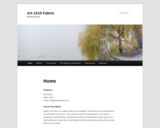
What is art? Why is it created? What is its meaning? These are some of the questions we will ponder in this class. This course serves as an introduction to art, with an emphasis on visual literacy and historical context. We will explore major works of art and architecture, drawn from a wide range of world cultures and periods, from ancient times to the present.
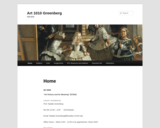
An introduction to the study of art and its history from ancient times to the present. In this course, we will study the history of Western art, beginning with the first objects created by prehistoric humans around 20,000 years ago and ending with the art and architecture of contemporary times.
The information presented in this course will provide you with the tools to recognize important works of art and historical styles, as well as to understand the historical context and cultural developments of Western art history through the end of the modern period. Introductory readings paired with detailed lectures will provide you with a well-rounded sense of the history, art, and culture of the West up through modern times.
At the end of this course, you will be able to identify key works of art and artistic periods in Western history. You will also be able to discuss the development of stylistic movements and relate those developments to important historical events.

Introductory course offers various windows into the development of human expression through the arts, spanning prehistory to the 21st century. Using art from diverse cultures and time periods, we will explore the way that art functions within broader societal trends and ideas, both reacting to and influencing major historical moments. Students will become comfortable with speaking and writing about specific art-historical styles, issues and key terms, and be able to approach art in both a formal/visual and historic context. They will also learn how to navigate and explore their own specific interests within the history of art and become aware of resources that will guide them to further complexify their own research and writing.
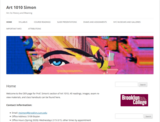
Introduce students to major works of art from cultures around the world, spanning ancient to modern periods. We will focus on developing skills of formal analysis by closely studying works of painting, sculpture, and architecture. We will also discuss the objects chosen in their historical, political, sociological, and religious contexts in order to better understand their meaning and significance.
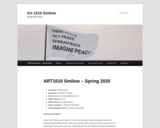
What is art? Why does it matter? This course presents a general global view of art history through slide lectures, class discussions, video resources and a museum visit. It selectively surveys the visual arts, beginning with the first objects created by prehistoric humans around 20,000 years ago and ending with the art and architecture of today, covering concurrent historical periods in Europe, Asia, Africa, and the Americas.
Using art from diverse cultures and time periods, we will explore the way that art functions within broader societal trends and ideas, both reacting to and influencing major historical moments.
You will become comfortable with speaking and writing about specific art historical styles, issues and key terms, and be able to approach art in both a formal/visual and historic context. You will also learn how to navigate and explore your own specific interests within the history of art and become aware of resources that will guide you to further your own academic pursuit

Introduces art and the academic discipline of art history. Using the discipline’s technical vocabulary, analyzes the standard visual, material and symbolic components of art. Addresses cultural products created from the Neolithic through to the end of the Western Middle Ages. Analyzes the purpose of art. Examines painting, drawing, sculpture and architecture in historical, political and cultural context. Analyzes art's function within society. Critiques how successive movements and styles are indebted to the past and to influences from other sources. Introduces key movements, important artworks and the biographies of individual artists.